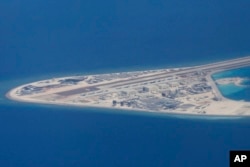Officials in Beijing are expected to take money from non-defense sources this year to solidify their military control in the disputed South China Sea following a proposed slowdown in formal defense spending.
China will increase defense spending by 7.5 percent this year, according to a draft budget report submitted to a National People's Congress session Tuesday. That increase would bring spending to $177.6 billion. The budget grew 8.1 percent last year.
Consistent with past practice, the government will protect and possibly expand its already dominant military presence in the South China Sea by drawing from civilian departments and even private Chinese companies, maritime scholars believe.
China claims about 90 percent of the 3.5 million-square-kilometer sea ranging from Hong Kong to Borneo. Brunei, Malaysia, the Philippines, Taiwan and Vietnam also claim all or parts of the same sea. China’s use of naval ships and military aircraft in contested waters has riled the other claimants since 2010, prompting Washington to send some of its own as a deterrent.
“China’s expansion in the South China Sea is a comprehensive effort,” said Oh Ei Sun, senior fellow with the Singapore Institute of International Affairs. “It involves the military but it also involves even the private sector.
“So, you might see a slight decrease in strictly military activities and maybe even installations, but the efforts to claim a large part of the South China Sea to be their own, I think that will still go on,” he said.
Multi-agency defense spending
China cites historical usage records to claim sovereignty over the sea, including its wealth of fisheries and fossil fuel reserves. Scholars say the People’s Liberation Army Navy has made the sea’s control a priority as the total number of ships rose from 512 in 2012 to 714 ships now.
And the navy gets help already. State-run oil driller CNOOC Group has buffered China’s claims by drilling in waters disputed by Vietnam, and private firms based in China reclaimed land to help the government get a foothold on otherwise uninhabitable islets.
Two years ago, the Chinese Academy of Sciences’ Institute of Acoustics and Tongji University in Shanghai said they would build a “long-term observation network” covering the South China and East China seas. CNOOC and China’s Earthquake Administration were also part of discussions about the network, which is due to share data with other countries. The project will bolster the legal basis for Chinese maritime claims, analysts said in 2017.
“The PLA operates businesses which accrue income for the acquisition of military products and other sources of income can be drawn from for example the ministry of science so that they can engage in exploring under the term of science diplomacy,” said Stephen Nagy, senior associate politics and international studies professor at International Christian University in Tokyo.
A lot of Chinese military infrastructure construction projects are “designed to be dual use and draw funding from local and national non-defense coffers,” according to a study by the China Power Project under U.S.-based think tank Center for Strategic & International Studies. Non-defense agencies should reimburse for disaster relief funded by the defense budget, the study adds.
The Chinese government could sell U.S. Treasury bonds as well if it needed more money, said Termsak Chalermpalanupap, fellow with the ISEAS Yusof Ishak Institute in Singapore.
Pressure to make cuts
The People’s Liberation Army could also delay or cut back endeavors elsewhere to “maintain the pace of strengthening China's position in the South China Sea,” said Denny Roy, senior fellow at the East-West Center think tank in Honolulu.
Military cutbacks might make little impact for now because the once ambitious Chinese island-building in the South China Sea is “finished” except for maintenance, Chalermpalanupap said.
“I think the overall economy of China is slowing down, so I think they have to be more careful on what they are spending in the defense side,” Chalermpalanupap said. “I think no more features to build. They have what they needed.”
China can lock in its current holdings, which include the entire 130-islet Paracel archipelago and seven features in the Spratly islands, partly through diplomacy with the other governments that contest its maritime sovereignty, Nagy said. One goal, he said, would be to stop any active multi-country effort to roll back Chinese control.







